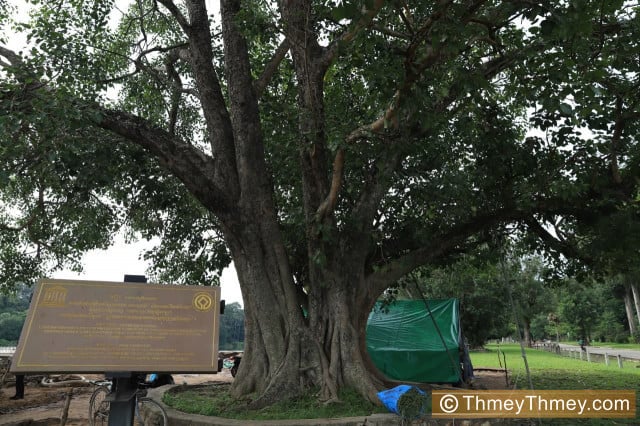The Varied Origins of the Bodhi Trees at Angkor

- By Isa Rohany
- and Ky Chamna
- February 12, 2022 7:51 PM
While some of the trees were planted in the 1950s, others may be centuries old, researchers say
SIEM REAP--As the month of April approaches, tropical heat keeps on rising, soon to reach its highest level around that month.
April also means Khmer New Year when families and friends gather to celebrate and also travel to many parts of the country, and especially to Siem Reap Province to visit Angkor or to Sihanoukville to spend time on the beach.
The Angkor Archeological Park in April usually means visitors touring under a sunny sky and often a scorching heat, which can prove difficult for visitors to handle. Cambodian tourists can be seen wearing traditional palm-tree leaves hats or moak t’noat, kramas—that traditional Cambodian scarf that comes in many styles and colors—and of course sunglasses. Those Cambodian visitors then become the latest of the millions of visitors, foreign or residents of the country, who have and will come to this World Heritage site during their lives.
Before heading for the stone causeway that goes over the moat and leads to Angkor Wat, one may decide to stand or sit along the moat under the large Bodhi trees whose branches and leaves form canopies and, being near the causeway, offer a perfect viewpoint from which to photograph the long galleries and five towers of this famed temple.
These big and yet delicate trees are thought to be nearly 100 years old and are believed to be among the oldest plants in Angkor Park. They also are an important element in Buddhism as it is believed that the Buddha sat under a Bodhi tree when he attained Enlightenment—the presence of these natural living towers today does add value and draw attention to the temples in the park.
While no written document can confirm this, according to oral tradition, these Bodhi trees in front of Angkor Wat were planted during the 1950s.
Im Sokrithy, an archaeologist and historian with the Apsara National Authority—the Cambodian government institution managing Angkor Park in Siem Reap Province—said that he has never seen any documentation as to when the trees were planted. However, the word is that they were planted in the mid-1950s during an event marking the 2,500th anniversary of the Buddha attaining the transcendent state of nirvana, he said. It is believed that the late King Norodom Sihanouk had this species of Bodhi tree imported from Sri Lanka along with sariras, that is, Buddhist relics.
In addition to the large Bodhi trees near the causeway leading to Angkor Wat, Sokrithy said, there are many Bodhi trees in Angkor Park that were planted during the 1990s through the Dharma Yatra (Buddhist pilgrimage) program.
Mao Sokny, architect with the Apsara Authority, agreed with Sokrithy. As he explained, he has seen references to these Bodhi trees in documentation from the 1950s and 1960s, and people during those decades were seen to be selling items in the shade of these trees.
While conducting field studies in 1994 and 1996, Sokny said he had seen more of these trees being planted along Angkor Wat’s moat.
But the two most famous Bodhi trees at Angkor located next to the Naga sculptures at the Spean Hal causeway bridge remain the largest ones, he said. “We cannot know for sure, but they might be over 100 years old,” he added.
Krem Kroun, a temple restoration worker, said that he remembers seeing these trees in the 1970s although he did not get close to them at the time.
Kroun was a Buddhist monk at the time and he would only walk on and close to the grounds of Angkor Wat where his pagoda was located. Since the trees were some distance away, he never walked by them. “At the time, the trees were…just a few branches [far away],” he said. “I only walked to the pagoda. I never walked up to the western side since the forest over there was thick.”
Venerable Pin Sem, head monk of the Reach Bo Pagoda in Siem Reap City, believes that the trees were planted during the 16th and 17th centuries when the country’s population was converting to Buddhism and renouncing Brahmanism, the Bodhi tree having such an importance for those of Buddhist religion, he said.
For example, the Bodhi trees at Angkor Wat clearly demonstrate the immense respect of the Buddhists for their religion. “The reason why they planted them at the Angkor Wat temple and no other temple is that this very temple was transformed into a large pagoda—Wat or Watta—inside the city and that is why the temple carries the name of Angkor Wat,” Sokrithy said. “The place had become the Buddhist sanctuary for the city after the Angkor Period—Buddhism always has some jewels to represent it.”
As he explained, there are five “jewels” that represent the religion of Buddhism and some pagodas may have all of them while others may lack a few. “These are: statues of Buddha, Pāli Canon scriptures, relics (such as remains of Buddhist monks or nuns), stupa and Bodhi trees.
“For those who study Buddhism, it is known that, during the period, no one dared to build the statue of Buddha. Therefore, people could only plant Bodhi trees as substitutes,” Sokrithy concluded.















